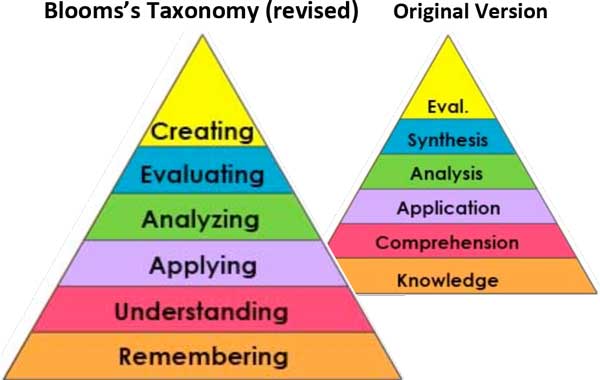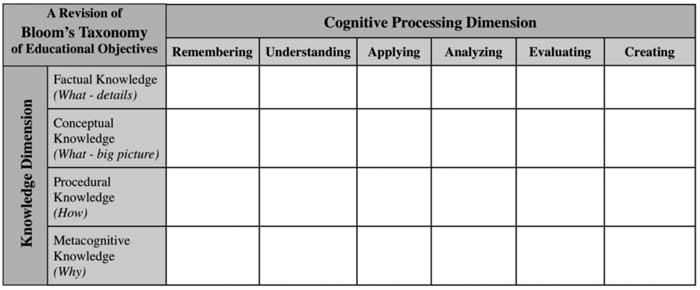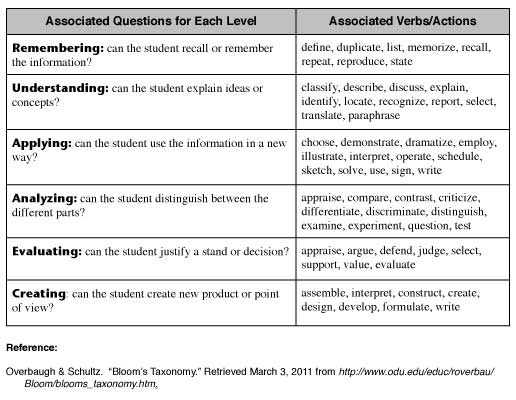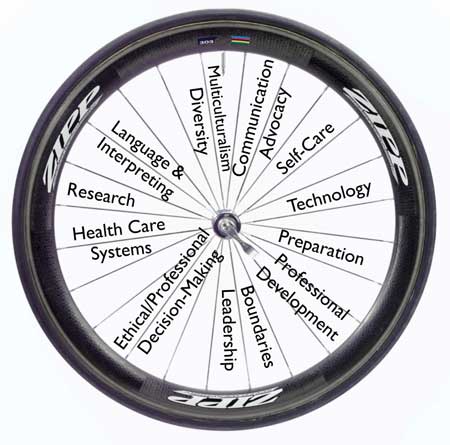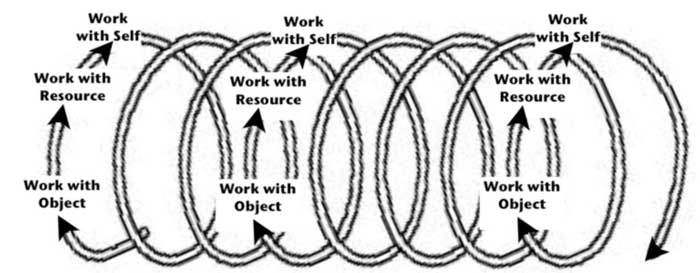A Framework for Online Education for Interpreters
A Framework for Online Workshops
 This information is based on a chapter by Bowen-Bailey “Just want the doctor ordered? Online possibilities for healthcare interpreting education,” in
This information is based on a chapter by Bowen-Bailey “Just want the doctor ordered? Online possibilities for healthcare interpreting education,” in
Swabey & Malcolm, ed. In Our Hands: Educating Healthcare Interpreters
http://gupress.gallaudet.edu/bookpage/IOHbookpage.html
Determining Objectives
Early on, it is important to identify learning objectives that meet the educational needs of the target audience. Since many of the workshops we have created are for working interpreters, sometimes with years of experience, we seek to have objectives that move to the the more demanding of the task’s in Bloom’s taxonomy.
Fine Tuning Objectives
Learning is multi-dimensional, so the taxonomy on the left provides a more nuanced approach to developing objectives. We may focus on knowledge or skills – and this may come at all of the different levels that Bloom identified in his taxonomy. For Body Language workshops, we have found it helpful to use the taxonomy and place objectives in the different boxes, rather than just listing the objectives. It gives participants a better idea of what levels and types of knowledge and skills they will be asked to use and develop in the workshop.
Writing Objectives
The chart to the right gives some ideas of questions that are associated with each level and what action verbs might be associated at that level. Notice that “interpret” is a verb at the highest level, and “evaluate” is at the next highest. So, asking people to both create interpretations and then evaluate their own and peer’s work, calls on higher orders of skill.
The challenge is that this type of workshops is harder to design, administer, and evaluate than a workshop that stays at the remembering and understanding levels. In order to meet the demands of raising the level of our profession, there is no question in my mind that we need to push people to tackle the higher challenges.
One Spoke in the Wheel of Professional Development
Any educational experience, whether online or in-person, needs to understand how it fits into the scope of other professional development opportunities. The Body Language workshops have been developed in the context of the CATIE Center’s work to develop Domains & Competencies for Healthcare Interpreting as well as a Healthcare Interpreting Career Lattice.
The image of the bicycle wheel to the left shows all the domains identified by the CATIE Center at St. Catherine. Creating a resource that fits into a larger framework helps participants understand both what they are getting in the workshop – as well as what other areas they need to address to further their own development.
A Vygotskyan Process
When we move into the content of the course, we try to be very conscientious of a progression from less complex to more complex material – so that as people go through the process, they will develop competence and confidence to be able to handle more and more challenging material.
With these activities, I use the structure based on Vygotsky’s understanding of learning as a social process that takes place in 3 steps:
- Work with Object – Have participant work on their own with some task to develop their own questions
- Work with Resource – Use some type of resource (such as video or mentor) to help answer the questions developed in the first step
- Work with Self – Integrate what is learned from the resource by working with the object again but incorporating new learning
This three step process is then repeated to hopefully create a spiral of learning where participants can work with new and more challenging concepts that moves them forward in their professional development.
Moving the Zone of Proximal Development
Another of Vygotsky’s concepts that plays an important part of the framework is the Zone of Proximal Development. The graphics to the left illustrate this. In designing the workshop, we want to try to find tasks that people can take on which are in the ZPD. (It’s the Goldilocks area of education – not too hard, not too easy.) And then provide the appropriate supports that help people internalize new skills.
In moving through the three steps of Vygotysky’s framework for learning, participants have the opportunity to try out and practice knowledge and skill within their Zones of Proximal Development – and if the appropriate resources are present, it will cause a shift in the person’s competency.
If you contrast this Initial ZPD and the Transformed ZPD, you will notice that the second ZPD has shifted to the left and the area of “Can Do Tasks Independently” has grown. And that, of course, the goal of any type of interpreter education – to increase our capacity to function as a practice professional.
Putting the Theory into Practice
Theory is well and good, but it is often helpful to see how this is carried out in an actual workshop or course. Through the CATIE Center at St. Catherine University, we have created a sample Body Language workshop that draws on activities from the 6 different courses that make up series. You won’t be able to see how the activities build on each other from more simple to more complex, but you will be able to see how the Vygotskyan structure is carried out in the activities.


